How many people would have died if an atomic bomb had been dropped on Tokyo in early 1945, instead of firebombs? Before you accuse me of excessive obsession with morbidity (as one anonymous e-mailer recently did), let me explain to you how I came to ask myself this question, and what the consequences of the answer are.
Before the dropping of the atomic bomb on Hiroshima and Nagasaki, there was the burning of Tokyo. Operation Meetinghouse, the early March 1945 raid on Tokyo that involved over 330 B-29s dropping incendiary bombs from low-altitude at night, killed roughly 100,000 people, and may have injured and made homeless an order of magnitude more. As with all statistics on the damage caused by strategic bombing during World War II, there are debatable points and methodologies, but most people accept that the bombing of Tokyo probably had at least as many deaths as the Hiroshima bombing raid, and probably more. It is sometimes listed as the most single deadly air raid of all time as a consequence.
So it is understandable that many people, including myself, point to Tokyo whenever people want to talk about Hiroshima and Nagasaki. You can’t see the atomic bombings in isolation. The practice of targeting civilian areas with massively destructive aerial bombing had already been done before. And to some, the atomic bombs were just a refinement of the art of area bombing — a more efficient means to accomplish the same ends.1
However, there are a few points that I fear get missed in that kind of equivalence. I certainly agree that the philosophy of bombing used at Hiroshima and Nagasaki wasn’t a new one. Indeed, the experience of firebombing gave a lot of guidance to the question of nuclear targeting. The goals were similar, though the people planning the atomic bombs emphasized the raw terror that they hoped such a spectacle would inspire.
But I depart from the standard comparison in two places. The first is the idea that since the atomic bombings were not original in targeting civilians, then they do not present a moral or ethical question. As I’ve written about before, I think the question of morality gets more problematic. If the atomic bombings were one-off events, rare interventions to end the war, then it might (for some) be compelling to say that they were worth the price of crossing over some kind of line regarding the deliberate burning of civilians to death en masse. But if they were instead the continuation of a well-established policy of burning civilians to death en masse, then the moral question gets much broader. The question changes from, Was it morally justified to commit a civilian massacre two times?, to Was it morally justified to make civilian massacre a standard means of fighting the war?
I want to state explicitly that I don’t think, and I don’t want my phrasing to imply, that the answer to the above is necessarily an unequivocal “no.” There are certainly many moral frameworks that can allow for massacres (e.g. ends-justify-the-means). But I prefer to not dress this sort of thing up in euphemisms, whether we think it justified or not. Massacre means to deliberately and indiscriminately kill people. That is what you get when you bomb densely-populated cities with weapons that cannot distinguish between civilians and members of the military. Incendiary raids and atomic bombs certainly fall in this category, whether one thinks that the circumstances required them or not.
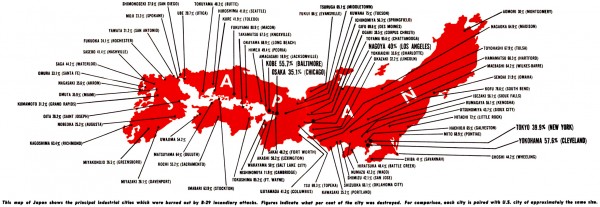
Japanese cities destroyed by strategic bombing in World War II. More information about this map here.
The second place I depart is a technical one. There are several important differences between the effects of firebombing and atomic bombing. They are not, even in the case of the bombing of Japan, strictly equivalent from the point of view of their effects or their outcomes.
The Tokyo firebombing raid was a relatively slow (compared to an atomic bomb), massively-distributed attack. The Tokyo raid involved hundreds of B-29 bombers arriving and attacking over the course of several hours. Such massive groups of B-29s could be heard and tracked from a considerable distance. They spread their bombs over a large area of the city, with the goal of creating a mass conflagration that would be impossible to control. They could be fought against with interceptors and anti-aircraft guns; air-raid alarms could be sounded; civilians could flee to shelter, or outside of the city itself. This is not to imply that any of these strategies were necessarily effective, and it does not necessarily make firebombing raids any more “humane.” But it does change the outcome quite a bit, when compared to an atomic bomb attack.
The atomic bombing raids of Hiroshima and Nagasaki were fast, near-instantaneous attacks. They involved a single B-29 weather plane in advance, and then two or three B-29s approaching the city, one with the bomb itself. This means that effective air-raid warning was minimal, because it was not possible to distinguish an atomic bomb attack from a reconnaissance or weather flight, all of which were common by that late stage in the war. (And obviously any hope of detecting an atomic bomb attack was impossible prior to Hiroshima.)
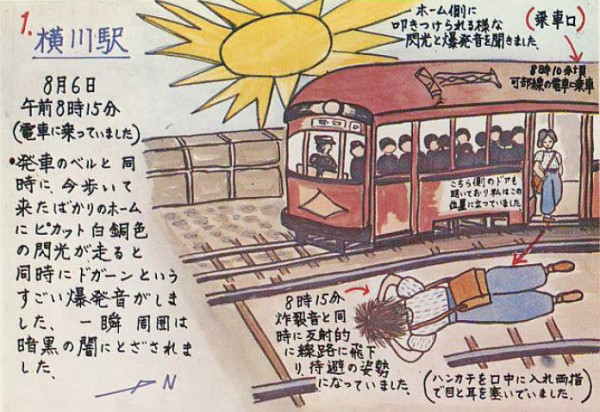
Drawing by Goro Kiyoyoshi of his memories of the Hiroshima attack. “I got on a streetcar of the Kabe line about 8:10 AM. The door was open and I was standing there. As I heard the starting bell ring, I saw a silver flash and heard an explosion over the platform on which l had just walked. Next moment everything went dark. Instinctively I jumped down to the track and braced myself against it. Putting a handkerchief to my mouth, I covered my eyes and ears with my hands.” From Unforgettable Fire: Drawings by Atomic Bomb Survivors (1977).
The primary acute effects of the atomic bombs were blast and thermal radiation. The former travels at the speed of sound, the latter significantly faster. (The rays are transmitted at more or less the speed of light, but the intensity and duration of the thermal pulse is a more complex phenomena and unfolds over the course of several seconds.) The blast knocks down buildings. The thermal radiation heats and burns. Both contribute to the starting of fires — the thermal radiation directly (for certain materials), the blast wave indirectly by knocking over flammable materials, stoves, candles, etc. After Hiroshima there was a significant firestorm, as with incendiary bombing, but there was not after Nagasaki. There was no effective preparation for such an attack — perhaps if they had the foresight of some later Civil Defense techniques, some lives could have been saved (different shelter types did affect the fatality rates significantly, even close in to the zero point), but obviously this was not quite in the cards during the war itself, when the atomic bomb was such a novelty. There was no time for shelters, no time to flee the city, no time even for real comprehension of what was happening — a bright light followed by a crushing blast, followed by fire. For those who survived the blast and fire, there were radiation effects, if they were with a few kilometers of the epicenter. This could range from acute radiation sickness and death with several weeks, to an increased cancer risk over the course of their lives.
Are the atomic bomb effects significantly different from firebombing to warrant putting them into different ethical or moral categories? One could argue the point either way. I tend to think that they are both pretty terrible forms of suffering, but they are not identical. In many ways the atomic bombing effects were significantly worse for the people living in the target cities — all of the suffering of firebombing accelerated, with a few new terrors added into the mix, and with less warning.
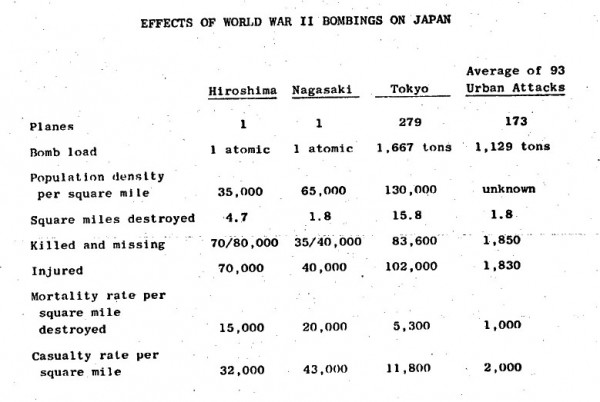
Table from a 1963 Office of Civil Defense report, “Survey of the Thermal Threat of Nuclear Weapons,” by Jack C. Rogers and T. Miller. These numbers are not necessarily authoritative, but lay out the situation well: atomic bombs have much higher mortality and casualty rates per square mile than firebombing, but destroy proportionally smaller amounts of area.
But the equivalence argument also misses some important differences in how deadly the atomic bombs were. The firebombing of Tokyo did, indeed, kill the most people of any air raid in history — from 80,000 to over 100,000 dead in a single raid. But the city of Tokyo had some 5 million people living in it. In the areas targeted, there were 1.5 million people living. So that means that it killed no more than 2% of the total population of the city, and no more than 7% of the people who lived in the targeted areas. The bombing of Hiroshima killed between 90,000 and 160,000 people in a city of 345,000 or so. So that is a fatality rate of 26-46%, depending on whose fatality estimates you go with. The bombing of Nagasaki killed between 39,000 to 80,000 people in a city of 260,000 people or so. So that is a fatality rate of 15-30%.
So to put it another way, the Hiroshima bombing was around 5 times more deadly than the Tokyo raid per capita, and the Nagasaki bombing was maybe 4 times more deadly. The total number dead is similar in all three cases, but the total number of people possible to kill in Tokyo was much higher than the number of people in Hiroshima and Nagasaki.
This isn’t the whole story, though. There is a subtle technical difference mixed in here. Firebombing on par with the Tokyo raid spread a moderate chance of death over a large area. The atomic bombs dropped in World War II spread a very high chance of death over a relatively small area. So depending on the target in question, the difference in fatalities might or might not matter. The Hiroshima bomb was perfectly capable of killing something like half of the city — but it was a pretty small city, compared to Tokyo. Tokyo has areas of incredibly high density, but also large areas of relatively moderate to low density.
So why does this matter? From an ethical standpoint, I’m not sure it does. The targeting of civilians for mass destruction seems to be the core ethical issue, whether you do this by means of fire, neutrons, or toxic gas. But I do think we end up underestimating the effects of the atomic bombs if we see them as exactly equivalent to firebombs. There is an error in seeing the atomic bombs as just an expeditious form of firebombing — it both overstates the deadliness of firebombing while understating the deadliness of atomic bombs.
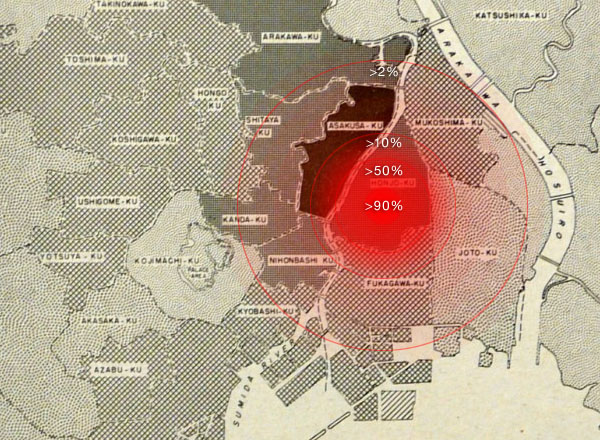
This map gives a rough indication of the methodology used to construct the casualty estimates for a Little Boy bomb targeted on World War II Tokyo. Percentages are expected average fatality rates. The actual method used (see below) used many more gradations of difference. One can see, though, the way in which the most intense of the effects of the atomic bomb are highly localized relative to the total size of Tokyo. The underlying population density map of Tokyo comes from the very useful Japanairraids.org.
All of this is what led me to the question I opened with: What if, in some hypothetical alternative universe, instead of launching a firebombing raid in early March 1945, the US was able to drop the Little Boy atomic bomb onto Tokyo? What would the casualties have been for that raid?
Obviously an exact answer is not possible. But we do have population density maps of Tokyo, and we do have records on the relationship between distance from “ground zero” and percentage of population killed. There are lots of uncertainties, here, regarding the types of buildings, the differences in geography, and other things that are hard to estimate. But let’s do a rough estimation.
If we transpose the effects of Hiroshima — a 15 kiloton bomb detonated around 1,968 feet above the ground — to the population densities of Tokyo, what is the result? I don’t want to clog up the blog post with a detailed explanation of the methodology I’ve used, so I’m putting it at the end with the footnotes. The basic gist of it was this: I took a population density map of Tokyo from 1940, divided the different density areas into different layers in Photoshop, then selected radii based on bomb effects and did pixel counting. I used all of this to come up with rough minimum-maximum estimates of how many people lived in areas at different regions from the bomb blast, and then multiplied those population counts against known average fatality/casualty rate data taken from Hiroshima.
I looked at two ground zeros, to further emphasize the intense locality of a Hiroshima-sized atomic bomb attack (compared to a firebombing raid). If targeted on the moderately-dense Honjo area (which is more or less the center of the firebombing attack), one could roughly expect there to be between 213,000 and 344,000 fatalities, and between 442,000 and 686,000 injuries. This is the ground zero shown in the above image. If you move it north-west by only 1 km, though, to the more densely populated Asakusa area, the numbers change to 267,000 to 381,000 dead and 459,000 to 753,000 injured.
So if the Hiroshima bomb had been dropped on Tokyo, it probably would have destroyed less area than the March 1945 Tokyo firebombings — something like 5 square miles, compared to the 15 square miles destroyed by firebombing. However it would have killed between two and four times as many people who died in the firebombings, and injured possibly fewer or the same amount of people.
These numbers seem roughly plausible to me, even given all of the uncertainties involved, and they align with the rough guess one would make from the relative area destruction and casualty rates cited earlier. It is of note that the shifting of an atomic bomb’s aiming point can increase total casualties by several tens of thousands of people in a city the density of Tokyo; firebombing is probably not quite as dependent on any given aiming point, given how much lower the accuracy was.
Finally, it is worth noting that the Tokyo firebombing was much more fatal than most of the other firebombing raids. As the first low-altitude, massed night B-29 incendiary raid, against Japan’s highest-density city, it was especially fatal. Later raids killed, on average, orders of magnitudes less, both for the reasons given at the beginning (e.g. fleeing when you hear hundreds of B-29s in the distance), and because of much lower population densities. Had Hiroshima been firebombed, the fatalities would have certainly been much lower than the atomic bombings, because the Tokyo case is in fact an anomalously high one.
Atomic bombings may be ethically no better or worse than firebombing raids like Tokyo, but to regard them as simply an expedient form of firebombing misses a key point about their relative deadliness: If you have to pick, and you get to pick, one should choose to be firebombed, not atomic bombed — unless you know exactly where the bombs are going to go off.
Detailed methodology for the casualty calculation
- The only population density map of Tokyo that I was able to find for this period was from 1940. It isn’t perfect for this purpose, because it has two major categories that are open ended (“Less than 30,000” and “135,000 and over” per square mile), which means we are left with some rather broad estimates on the high and low ends of things. But it’s better than nothing.
- We know that during the March 1945 raid, the US targeted the densely-populated area just east of the Imperial Palace. So we can put our atomic bomb ground zero there too and not feel like we are doing anything wrong, though actual targeting strategy would probably vary. I placed one ground zero in the Honjo area, which was more or less the aiming point for the firebombing raids. I also did the calculations for a ground zero in the very densely populated Asakusa area, to illustrate how the difference of only 1 km in ground zero location could lead to very different results.
- I took the map and color-coded each of the population density regions in Photoshop, each on their own layer. This allowed me to use the Histogram tool to count the pixels on each layer within a selected circle. I then correlated what a pixel meant in terms of a square mile, given the scale of the map. The resolution of everything means there is some rounding, of course, but this was never an exact science to begin with.
- I then made pixel count measurements corresponding to circles corresponding to 0.1 km, 0.2 km, and so on in 0.1 km intervals, up to 2 km, and then in 0.5 km intervals up to 4.5 km. I then (in Excel) used these to extrapolate minimum and maximum populations within those areas. The minimum count was pretty easy (because I could just assume nobody lived in the least dense areas), but I tried to be conservative regarding the maximum counts, assuming that the “135,000 and up” areas only would go up to 165,000 or so on average. This might be incorrect, so these figures might be either under- or overestimating things considerably for the very dense Asakusa area.
- I then took an average fatality/casualty chart that was produced by the US Army Corps of Engineers using data from Hiroshima (figure 3–10H, page 70 from Report of the Joint Commission for the Investigation of the Effects of the Atomic Bomb in Japan; Volume VI) and correlated their percentage estimates with my population estimates.
- Things not controlled for include building type, the question of whether a firestorm would be formed in the same way, and time of day issues (e.g. the difference between an early morning and a night bombing). I also have not tried to estimate what the radiation effect differences would have been, obviously. This should be taken as only a rough estimate.
The end result of all this was a calculation that between 2.4 million and 4 million people lived within a 4.5 km radius of my ground zeros in 1940. Which seems plausible on the face of it, given that Tokyo had a population of around 7 million and the area in question encompasses the densest parts of the city.
- On this, see esp. Michael Gordin’s Five Days in August, and, perhaps, my review of it. [↩]
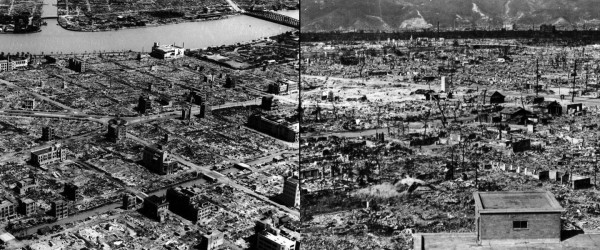



I think a better question would be what differences would there be if the Hiroshima bomb and been used on a city such as Berlin or Munich, cities built much differently to most in Japan?
Excellent work, Alex. Excellent and original.
Interesting — nice work.
What usually gets overlooked in the firebombing/atomic discussion is what was happening aside from that, and would have continued to happen even in the absence of an invasion — namely the blockade. Given Japan’s population and agricultural potential, this meant deliberate starvation. By 1945 even fishing boats were being wiped out. I don’t think anyone has done the statistics of the resulting deaths, which were not directly from starvation but from diseases due to malnutrition, but the toll was increasing and eventually would have been equivalent to the bombing toll. Children, the elderly, and women were of course the worst hit. Any discussion of the bombing morality should bear the blockade’s (im)morality in mind.
Alex,
While it is true that later fire bombing raids killed far fewer people, this was the result of two important factors you don’t mention. 1) Wide fire breaks were made in most cities, which had the secondary effect of providing escape corridors for fleeing civilians. 2) Hundreds of thousands of leaflets were dropped by the U.S. Army Air Force warning where upcoming raids would strike. This allowed civilians to evacuate those cities.
The fact that nuclear weapons kill large numbers of civilians does not make them more effective weapons. It is their second greatest drawback (after radiation). Nuclear weapons have declined over the years precisely because military officers have (quietly) realized that they are quintessentially clumsy weapons. Your calculations emphasize the point.
Ward
Alex,
While this is a good hard science fiction thought experiment and work through, for which I commend you for sharing, and despite fully agreeing that if Tokyo got it first in the summer clothes wearing months of August, instead of Hiroshima, your estimates would definitely be accurate! I mainly take issue with there being no mention of the effect of how in spring/March the Japanese would be wearing more cover-all attire and so the proportion killed from flash burns, or complications due to them, would be considerably less than at Hiroshima – where everyone was sweltering in the heat, wearing next to nothing.
Apart from that, I still can’t shake feeling that there is a bit of an un-level playing field/assumption here that is glossed over when you are summing up, with the- “if you’d had to pick, being conventional bombed or nuclear bombed”/which raid would have killed more people, all things being equal? presentation.
To explain the un-level playing field that I see:
Firebombing lethality was reduced in Tokyo because people were at least familiar with the phenomenon of air raids and had a loose plan of action if an air raid was approaching. This plan of action naturally didn’t result in an 100% assured survival for everyone but nonetheless it saved lives in the congested city. If you control for this-forewarning-for want of a better word, the number of deaths from the conventional Tokyo raid would probably have been a bit higher.
While on the contrary, Hiroshima, and any lethality estimates based on that case of bombing, are increased precisely because people were totally unfamiliar about how to respond to it and increase their chance of survival. If you control for this, the total number of deaths from Hiroshima would have been much less, and therefore also would the lethality estimates for a Tokyo being nuked under the same precondition that people were as forewarned as they were about this new weapon.
One easily forgets that Hiroshima is psychologically like the 1937-8 Guernica air raid, a totally unexpected experience for city dwellers with the numbers killed per kilogram of TNT equivalent also being “anomalously” high when compared to later attacks on populations who were prepared. So as Ward’s comment above hints at, the 1963 Office of Civil Defense report’s chart shows in part, in the first two columns, the effects of a totally new weapon, in which the Japanese had no prior countermeasures towards, while the latter two columns show, in part, the diminishing returns in casualties per kilogram of bombs from conventional weapons as the Japanese had adapted and grown ever more accustomed to normal air raids.
Duck and Cover may seem absurd to a modern audience drenched in years of outright leftist hollywood propaganda towards it, but it did/does work.
Just have a look at how “Goro Kiyoyoshi” in your article survived-what he did was pretty much exactly a duck and cover countermeasure.
While Kiyoyoshi survived-as somehow instinctively he knew what to do- all those folks depicted on the tram most definitely died, not to mention that it is well known from survivor accounts that most of the deceased in Hiroshima died from totally preventable injuries – most inquisitive people naturally went looking in the sky for the “silver” flash of light and were essentially caught like deer in the headlights when the blast wave arrived and with hurricane force winds, blew glass shards and debris into their faces.
To do a fair comparison, and not an apples to oranges one, essentially you’d need to usher in the folks from Guernica 1938 into Tokyo for the conventional air raid-that is you would need to control for the civil defense measures in Tokyo that saved lives and the general psychology of people living in the city, who had thought about and prepared somewhat their plan of response if an air raid ever came bombing on their doorstep- not a fantastical thing to think about while your country is at war.
As it is, in part, the very unfamiliarity with the effects of nuclear weapons that was responsible for so much death in Hiroshima, this -“Deer in the headlights”- effect was reduced somewhat in Nagasaki in small part because survivors of Hiroshima told people in Nagasaki what to do-Duck and Cover- if they saw the brilliant “pika”/flash.
To reply to the last bolded statement in the article: Well I’m not sure exactly what you mean, is the conventional air raid going to carry the same TNT equivalent as the nuclear bomb? – If Yes, then the answer is that the nuclear bomb would result in less deaths, so you naturally should pick to be nuclear bombed.
If what you more likely meant was; of which scenario would you rather be trust into without any warning of the attack on Tokyo, a Little Boy nuke of 16kt in march or the conventional raid that occurred? – Well that simply depends on how many deaths would result from the little Boy bomb during March weather, if you showed that it would kill more than the conventional raid did, We’d pick the less lethal conventional raid, but if the risk calculation came out near exactly the same as the real Tokyo raid, well that’d be a tough choice.
Having thought about it, I’d again pick the nuclear bomb. As Flash-Bang and it’s essentially over, you can point to “over there” at ground zero and be fully sure that as long as I walk away from that death zone I’ll be ok – there is a kind of self orientating that takes/took place in survivors. On the other hand, there is pretty much nothing worse to me than the thought of running through a city with 100s of people trying to kill me in bombers overhead, all of them dropping thousands of bomblets, and being filled with anxiety, not knowing if by running you’ll run into a bomb falling on your head or if you stay put you’ll survive, is anywhere safe? am I running into danger? They essentially turn your entire city into a mine field, while you’re in the middle of it – and it is for this reason conventional air raids sound like far more of a “cruel and sadistic punishment” to me.
A comment and a question:
The 9/10 March incendiary raid on Tokyo was affected by weather. Low humidity and high winds gave excellent conditions for the fires to take hold. Probably why the raid is something of an outlier in terms of destruction for bombs dropped.
Would a nuclear strike package have survived Japanese air defenses in March of 1945? One of the reasons for going to low-level area bombing was the lack of night air defense over Japan. The Japanese were pretty aggressive by day until they ran out of gas and ammunition.
Another difference is that at least in theory the Tokyo firebombing was not irrevocable once started. American authorities could have stopped the several hours’ long raid before its completion, while once the Hiroshima/Nagasaki bombs were dropped it was a fait accompli.
This goes both ways: In Hiroshima and Nagasaki the attack was done and over in an instant and first response activities like searching for survivors in collapsed buildings could start pretty much immediately (assuming any first responders in the vicinity were still alive). Also there were no duds or bombs with delay fuses.
Lets not forget as well that the firebombing raids were intended to cause mass fires and literally burn out areas. The nukes on Japan ignited fires via thermal impulse and much of that was extinguished by the following blast wave. The fires then reignited from those that had not be snuffed out. This is part of my comment about the differences between cities in Japan and those of Europe..what would the fire damage have been in Europe? The firestorm in Dresden for example had bombers dumping incendiaries for hours, feeding those already burning increasing the chimney effect.
[…] Restricted Data The Nuclear Secrecy Blog: Tokyo vs. Hiroshima […]